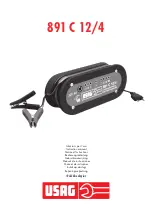
Specifications are subject to change. See bluesea.com/products/7606 for current information.
1
IMPORTANT SAFETY INSTRUCTIONS
1. SAVE THESE INSTRUCTIONS
This manual contains important safety and operating instructions for the BatteryLink® Charger model 7606.
2. WARNING RISK OF EXPLOSIVE GASES.
Working in the vicinity of a lead-acid battery is dangerous.
Batteries generate explosive gases during normal battery operation. For this reason it is of the utmost
importance that each time before using your charger, you read and follow the instructions provided exactly.
3. TO REDUCE RISK OF BATTERY EXPLOSION,
follow these instructions and those marked on the battery.
4.
This appliance can be used by children aged from 8 years and above and persons with reduced physical,
sensory or mental capabilities or lack of experience and knowledge if they have been given supervision or
instruction concerning use of the appliance in a safe way and understand the hazards involved.
5.
Children should be supervised to ensure they do not play with the appliance.
6. WARNING AVOID SERIOUS INJURY OR DEATH FROM FIRE, EXPLOSION, OR
ELECTRICAL SHOCK.
The BatteryLink® Charger is intended only for fixed installation by qualified
professionals. Improper installation can result in electrical shock, which may cause serious injury or death.
a. The BatteryLink® Charger is marked as “ignition protected” for operation in a small craft gasoline engine
space. HOWEVER: Connection or disconnection of any electrical cables may cause sparks, which could
ignite flammable gasses and cause explosion.
b. Never connect or disconnect electrical cables when explosive gasses may be present.
c. Always disconnect AC power sources before connecting or disconnecting the charger AC cord.
d. A circuit breaker or other means for disconnection from the supply mains must be incorporated in the
fixed wiring to the charger in accordance with wiring rules.
e. The AC supply cord should be protected by a Residual Current Device (RCD) suitable for personal shock
protection. Make AC connection in a secure manner that will avoid contact with water.
7. DO NOT OPERATE CHARGER IF IT HAS A DAMAGED CORD,
has received a sharp blow, been
dropped, or otherwise damaged in any way. The supply cord cannot be replaced. If the cord is damaged,
the appliance should be scrapped.
8. USE CHARGER FOR CHARGING ONLY THESE 12V BATTERY TYPES:
Flooded lead-acid, AGM, or TPPL.
Do not use your marine battery charger to charge non-rechargeable or dry-cell batteries that are commonly
used with home appliances. These batteries may burst and cause injury to persons and damage to property.
9.
Be sure area around battery is well ventilated while battery is being charged. Keep open flames and sparks
away from batteries, as these may cause explosion.
10.
Make or break DC output cable connections to battery only after making and verifying DC connections on
the charger, and disconnecting the AC supply to the charger.
11.
Do not make or break electrical connections to batteries while charging or for up to 30 minutes after charging.
12.
If a battery switch is installed, ensure battery switch is in the OFF position before making or breaking any
connections to the battery. If no battery switch is installed, ensure all accessories are OFF.
13.
Charger should be grounded to reduce risk of electric shock. Charger is equipped with an electric cord having
an equipment-grounding conductor. The charger should be properly wired and grounded in accordance with all
local codes and ordinances.
14.
For compliance with electromagnetic compatibility standard EN 55014-1:2006, DC out put cables must be
a fixed installation using non-extendable connectors such as ring terminals, and with maximum length
of 2 meters.






























